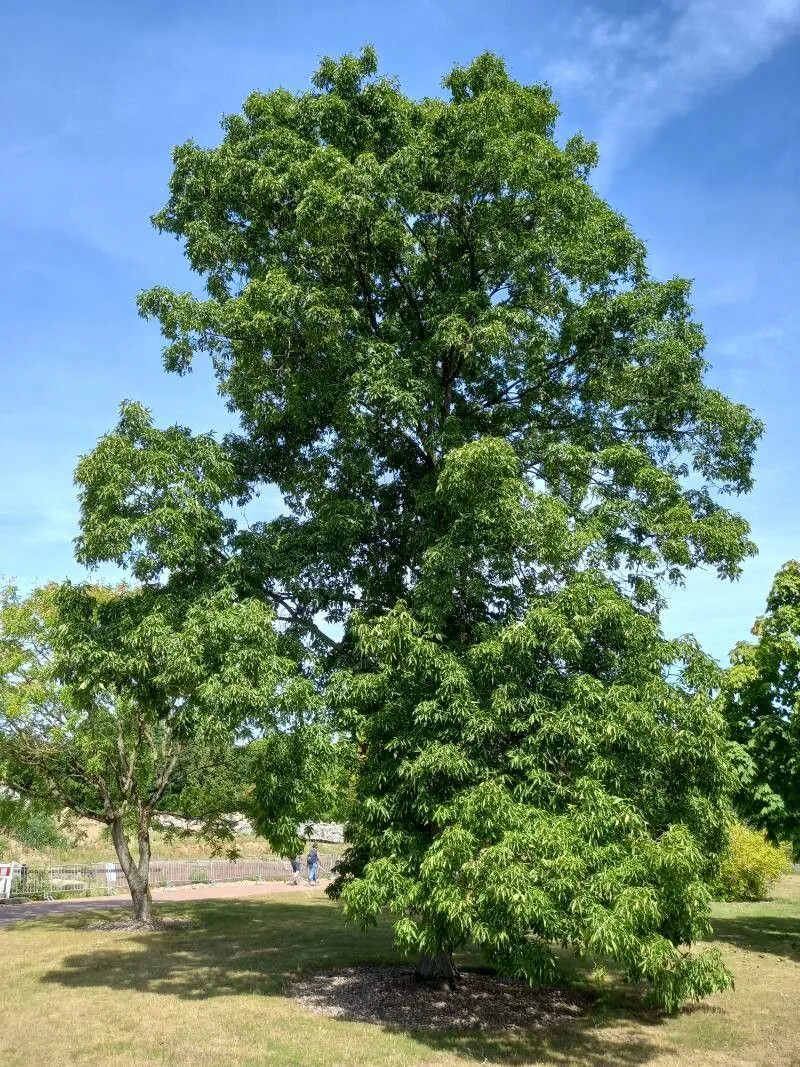
Author: (Mill.) K.Koch
Bibliography: Dendrologie 1: 598 (1869)
Year: 1869
Status: accepted
Rank: species
Genus: Carya
Vegetable: False
Observations: E. Canada to C. & E. U.S.A. and NE. Mexico
The Shagbark hickory, scientifically known as Carya ovata, is a remarkable tree species native to a wide geographic range stretching from Eastern Canada to the Central and Eastern United States, and extending into Northeastern Mexico. This species belongs to the Juglandaceae family and is well-known for its distinctive and rugged bark, which peels away in long, narrow strips, giving the tree its common name.
The Shagbark hickory is celebrated for its longevity and its ability to thrive in a variety of climatic conditions. It typically occupies deciduous forest landscapes where it contributes significantly to the ecosystem by providing a habitat and food for various wildlife species. The hickory nuts produced by the tree are a valuable food source for birds, squirrels, and other small mammals.
This tree can grow to substantial heights, often reaching between 70 and 90 feet, with some specimens surpassing even these dimensions. Its leaves are compound, usually consisting of five to seven leaflets, which turn a vibrant yellow in the fall, adding to the tree’s seasonal appeal.
Historically and economically, Shagbark hickory wood is highly valued for its strength, hardness, and resilience. It is commonly used in the manufacturing of tools, furniture, and for smoking meat due to the unique flavor it imparts. In the sphere of dendrology, or the scientific study of trees, the Shagbark hickory has been documented since 1869 with detailed classifications recorded in sources such as ‘Dendrologie’ by K. Koch.
Understanding and preserving the Shagbark hickory is crucial due to its ecological and economic importance. Future conservation efforts aim to maintain its population and protect against environmental challenges that threaten its natural habitats.
Eng: caryer ovale, noyer tendre, shagbark hickory, shellbark hickory, upland hickory
Pol: orzesznik pięciolistkowy
Deu: schindelborkige hickorie, schindelborkige hickorynuss, schuppenrindenhickory
Spa: caria blanca
Fra: carya blanc, caryer ovale, noyer blanc, noyer tendre, arbre à noix piquées, caryer blanc, noix douces
Swe: skidhickory
En: Shagbark hickory, Caryer ovale, Noyer tendre, Shellbark hickory, Upland hickory, Shag-bark Hickory
Fr: Carya blanc, Caryer ovale, Noyer blanc, Noyer tendre, Arbre à noix piquées, Caryer blanc, Noix douces
De: Schindelborkige Hickorie, Schindelborkige Hickorynuss, Schuppenrindenhickory, Schuppenrinden-Hickory, Weisse Hickory
Pl: Orzesznik pięciolistkowy
Es: Caria blanca
Sv: Skidhickory
© copyright of the Board of Trustees of the Royal Botanic Gardens, Kew.
© copyright of the Board of Trustees of the Royal Botanic Gardens, Kew.
© copyright of the Board of Trustees of the Royal Botanic Gardens, Kew.
Taken Sep 22, 2022 by Ha Anna (cc-by-sa)
Taken Jul 28, 2022 by Kai Best (cc-by-sa)
Taken Jul 27, 2022 by lily dood (cc-by-sa)
Taken Jun 4, 2022 by samuel11 (cc-by-sa)
Taken Oct 29, 2022 by Barbara Distephano (cc-by-sa)
Taken Oct 16, 2022 by JF SICURANI (cc-by-sa)
Taken Mar 8, 2021 by schmidt100 (cc-by-sa)
Taken Sep 22, 2022 by Ha Anna (cc-by-sa)
Taken Sep 22, 2022 by Ha Anna (cc-by-sa)
Taken Jul 27, 2022 by lily dood (cc-by-sa)
Taken Jul 10, 1994 by Daniel Barthelemy (cc-by-nc)
Taken Jul 10, 1994 by Daniel Barthelemy (cc-by-nc)
Taken Feb 26, 2022 by Andreas Schmid (cc-by-sa)
Taken Jul 28, 2022 by Kai Best (cc-by-sa)
Taken Sep 22, 2022 by Ha Anna (cc-by-sa)
Taken Jan 3, 2021 by Andreas Schmid (cc-by-sa)
Taken Jan 25, 2022 by Andi F (cc-by-sa)
Taken May 16, 1990 by Daniel Barthelemy (cc-by-nc)
Taken May 16, 1990 by Daniel Barthelemy (cc-by-nc)
Taken May 16, 1990 by Daniel Barthelemy (cc-by-nc)
Taken May 16, 1990 by Daniel Barthelemy (cc-by-nc)
Taken May 16, 1990 by Daniel Barthelemy (cc-by-nc)
Taken May 29, 2022 by Dieter Albrecht (cc-by-sa)
Taken May 18, 2022 by Marco (cc-by-sa)
Taken Jul 28, 2022 by Kai Best (cc-by-sa)
Family: Myrtaceae Author: (F.Muell.) K.D.Hill & L.A.S.Johnson Bibliography: Telopea 6: 402 (1995) Year: 1995 Status:…
Family: Rubiaceae Author: Pierre ex A.Froehner Bibliography: Notizbl. Bot. Gart. Berlin-Dahlem 1: 237 (1897) Year:…
Family: Sapindaceae Author: Koidz. Bibliography: J. Coll. Sci. Imp. Univ. Tokyo 32(1): 38 (1911) Year:…
Family: Asteraceae Author: A.Gray Bibliography: Pacif. Railr. Rep.: 107 (1857) Year: 1857 Status: accepted Rank:…
Family: Fabaceae Author: Medik. Bibliography: Vorles. Churpfälz. Phys.-Ökon. Ges. 2: 398 (1787) Year: 1787 Status:…
Family: Aspleniaceae Author: (Cav.) Alston Bibliography: Bull. Misc. Inform. Kew 1932: 309 (1932) Year: 1932…